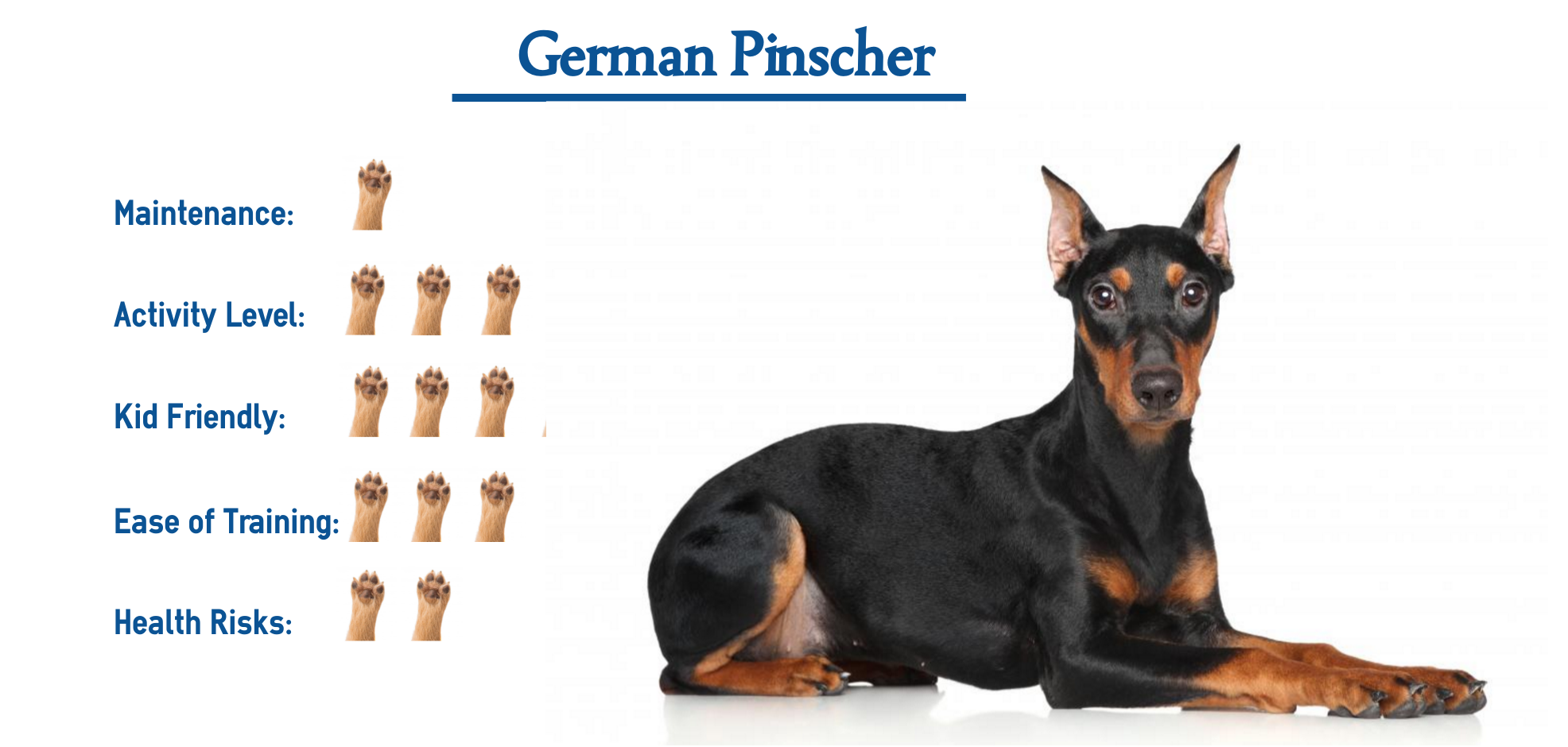The German Pinscher is one of those “kinds” of dogs that once someone hears their name, they automatically think they “know” what they are, but in truth, they’re probably thinking about a different “kind” of dog. After all, these guys are commonly mistaken for a vast number of other dog breeds, such as the:
- Doberman Pinscher, and “No,” the German Pinscher is not a smaller version of the Doberman. He is a much older dog breed that contributed to the development of Doberman Pinschers (but we’ll get into that later)!
As well as other breeds, including the:
- German Shepherd Dog,
- German Shorthaired Pointer,
- Black and Tan Hound,
- Bull Terrier,
- And other Shepherd Dogs.
And while it’s evident that the German Pinscher doesn’t look like many of these other kinds of dogs because of their natural tendencies and original purpose, it’s not uncommon for folks to “lump” these guys within the same classification of this somewhat more popular breed.
As a result…
The German Pinscher’s popularity has waned a bit, which is why we wanted to take a moment and discuss what it might be like to own one of these little guys so that if you’re ever allowed to get your hands on one, you’ll know for sure if that’s going to be a good idea or not! So, without further ado, let’s dive right in.
German Pinscher Fast Facts
Country of Origin: Germany
Original Purpose: Ratting
Breed Group: Working
Height: 17 to 20 inches at the shoulder
Weight: 25 to 45 pounds
Life Span: 12 to 14 years
Dog Breed Classification: Working group
Origin of the German Pinscher
The German Pinscher is an ancient breed from Germany and is believed to date back to the early 1600s. During this time, they were commonly referred to as “Rattenfanger,” which loosely translates to “rat catcher” or “ratter” in English. Ironically, even though this dog breed has existed since the early 1600s, the “official” standard wasn’t established until 1884 and wasn’t widely appreciated then.
As a result…
The German Pinschers numbers took a “hit,” which was only further exacerbated with the development of World War II, which decimated many domesticated animals throughout Europe. So much so that the German Pinscher dog breed nearly went extinct! Fortunately, these guys survived due to the “cross-breeding” efforts of some dedicated dog breeders, allowing them to eventually make their way to the United States in the early 1970’s.
Today, the German Pinscher is an “officially” recognized dog breed by the American Kennel Club (AKC). It is relatively popular within the United States, which should ensure his future for many generations.
Physical Characteristic
In appearance, the German Pinscher is a smaller version of its close cousin, the Doberman Pinscher. The ACK describes the German Pinscher as a mid-sized dog with a robust, muscular, strong, and beautiful square build. It is a very athletic dog known for its agility and endurance. The Pinscher has a short coat, usually of the colors rust, red, tan, blue, and black. He is black and tan or solid brown.
Grooming this dog is easy.
He doesn’t shed much; you only need to give him a quick brush every week. Just ensure he is clean and bathe him if he comes home covered in dirt or grime.
Temperament and Personality
By temperament, the German Pinscher is bold, alert, and very territorial. He has his space and doesn’t like it when a strange intrudes upon it. He is excellent with his human family, friendly, and loyal. He is very protective of the kids in the family and always looks out for them. They are, after all, a part of his herd.
He is also very stubborn…
He is an assertive and determined dog with a mind of his own and adamant about what he wants and where he wants to go. He loves you, but he considers himself to be your equal! Training and socialization are essential and should begin as early as possible. Use positive reinforcement techniques such as praise, tasty treats, and more play to get him to listen to your commands.
These guys are also…
He is a very energetic and social dog who wants his human family to depend upon him. He hates being left alone and needs enough exercise. He is brilliant and knows when he is being neglected. He resents that! It would be best if you made it a point to take him for a long walk every morning or evening. That will keep him happy. Also, take time to play with him. He is a very playful dog but gets bored quickly.
Potential Health Concerns
The German Pinscher is a very healthy dog breed, but he is vulnerable to certain genetic and other health disorders such as:
- Von Willebrand’s Disease,
- Hip Dysplasia,
- Elbow Dysplasia,
- Eye problems such as cataracts,
- Thyroid disorders,
- And cardiac disease.
However, many of these conditions can be avoided by working with a responsible German Pinscher dog breeder, which is why many of these guys will live a long and healthy life that averages around 12 to 14 years. But regardless of how carefully you choose your new pet, you never know what may happen. This is why we here at IndulgeYourPet always recommend that new pet owners consider purchasing a pet insurance policy for their new loved ones.
That is, of course…
Unless you have several thousand dollars that can be spent at any moment on your animal’s health care. Because if you have that kind of disposable income readily available, it’s possible that a pet insurance policy may not be suitable for you. The sad part is that not many of us have that cash lying around, so we feel it’s essential to have a quality pet insurance policy just in case. For more information on who we feel currently offers the “Best” pet insurance policies, please check out our Best Pet Insurance Companies article.



